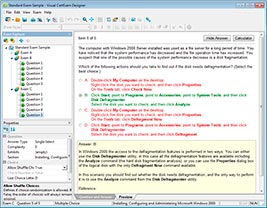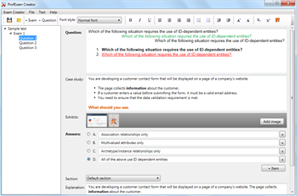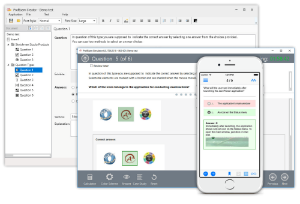Download VMware vSAN 6.7 Specialist.5V0-22.21.VCEplus.2025-04-02.68q.vcex
| Vendor: | VMware |
| Exam Code: | 5V0-22.21 |
| Exam Name: | VMware vSAN 6.7 Specialist |
| Date: | Apr 02, 2025 |
| File Size: | 286 KB |
How to open VCEX files?
Files with VCEX extension can be opened by ProfExam Simulator.
Purchase
Coupon: TAURUSSIM_20OFF
Discount: 20%
Demo Questions
Question 1
What are two prerequisites for using the TRIM and UNMAP capability of vSAN? (Choose two.)
- TRIM and UNMAP is enabled.
- The VM guest operating system supports ATA TRIM or SCSI UNMAP capability.
- The vSAN cluster is an all-flash architecture.
- Change the Object Space Reservation to 100.
- Deduplication and compression are enabled.
Correct answer: BC
Explanation:
The TRIM and UNMAP capability of vSAN is used to reclaim space on an all-flash vSAN cluster by discarding blocks that are no longer in use. In order to use this capability, the following prerequisites must be met:The VM guest operating system must support the ATA TRIM or SCSI UNMAP command. This will allow the guest OS to communicate with the vSAN datastore to inform it of blocks that are no longer in use.The vSAN cluster must be an all-flash architecture. TRIM and UNMAP can only be used on all-flash vSAN clusters, as it doesn't make sense on the hybrid vSAN cluster.This is explained in VMware vSAN documentation in the section "vSAN Space Reclamation"Reference: https://docs.vmware.com/en/VMware-vSphere/7.0/vsphere-vsan-70-admin-guide/GUID-7E8F6C98-7C0B-4D21-8F1A-F3A3A9F4F4A4.html The TRIM and UNMAP capability of vSAN is used to reclaim space on an all-flash vSAN cluster by discarding blocks that are no longer in use. In order to use this capability, the following prerequisites must be met:
The VM guest operating system must support the ATA TRIM or SCSI UNMAP command. This will allow the guest OS to communicate with the vSAN datastore to inform it of blocks that are no longer in use.
The vSAN cluster must be an all-flash architecture. TRIM and UNMAP can only be used on all-flash vSAN clusters, as it doesn't make sense on the hybrid vSAN cluster.
This is explained in VMware vSAN documentation in the section "vSAN Space Reclamation"
Reference: https://docs.vmware.com/en/VMware-vSphere/7.0/vsphere-vsan-70-admin-guide/GUID-7E8F6C98-7C0B-4D21-8F1A-F3A3A9F4F4A4.html
Question 2
A storage administrator is facing degraded performance for the VMs running on a vSAN enabled vSphere Cluster and needs an out-of-the-box tool to identify the root cause of the problem. Which tool should be used?
- top
- esxcli
- vmkfstools
- vsantop
Correct answer: D
Explanation:
This is explained in VMware vSAN documentation in the section "vSAN Tools and Troubleshooting"Reference: https://docs.vmware.com/en/VMware-vSphere/7.0/vsphere-vsan-70-admin-guide/GUID-7E8F6C98-7C0B-4D21-8F1A-F3A3A9F4F4A4.html This is explained in VMware vSAN documentation in the section "vSAN Tools and Troubleshooting"
Reference: https://docs.vmware.com/en/VMware-vSphere/7.0/vsphere-vsan-70-admin-guide/GUID-7E8F6C98-7C0B-4D21-8F1A-F3A3A9F4F4A4.html
Question 3
A vSAN Administrator would like to save some space on workloads that do not take advantage of deduplication techniques by leveraging vSAN Compression only.
Which set of requirements should be met?
- vSAN Deduplication and Compression must be enabled together, have vSAN version 6.6 or later, and have at least vSAN Enterprise license.
- vSAN cluster must be at version 7.0 U1 or later and have at least vSAN Advanced license in order to enable Compression only.
- vSAN Compression only feature is only available with VMC on AWS, so use VMware HCX to migrate such workloads to VMC on AWS.
- vSAN cluster must be at version 7.0 U2 or later and have at least vSAN Standard license in order to enable Compression only.
Correct answer: D
Explanation:
Reference: https://docs.vmware.com/en/VMwarevSphere/7.0/com.vmware.vsphere.vsan.doc/GUID-9F9ED2CB-8F62-4C1B-A7E2-3B8FA3FCCD77.html Reference: https://docs.vmware.com/en/VMwarevSphere/7.0/com.vmware.vsphere.vsan.doc/GUID-9F9ED2CB-8F62-4C1B-A7E2-3B8FA3FCCD77.html
Question 4
A vSAN administrator wishes to implement HCI mesh between two clusters that are located in geographically separate data centers.
Which recommendation should the vSAN administrator make for this configuration?
- A leaf spine topology is required for core redundancy and reduced latency.
- vSAN encryption must be disabled prior to configuring HCI mesh.
- NIC teaming must be implemented for the vSAN network VMkernel port.
- Both Layer 2 and Layer 3 communications are supported.
Correct answer: D
Explanation:
HCI Mesh allows you to connect two or more vSAN clusters together in a stretched cluster configuration, which enables you to share storage resources across the clusters. In order to implement HCI mesh between two clusters that are located in geographically separate data centers, the vSAN administrator should ensure that both Layer 2 and Layer 3 communications are supported between the two data centers. This will allow the vSAN clusters to communicate with each other over both the data and management networks.This is explained in VMware vSAN documentation in the section "HCI Mesh" Reference:https://docs.vmware.com/en/VMware-vSphere/7.0/vsphere-vsan-70-admin-guide/GUID-7E8F6C98-7C0B-4D21-8F1A-F3A3A9F4F4A4.html HCI Mesh allows you to connect two or more vSAN clusters together in a stretched cluster configuration, which enables you to share storage resources across the clusters. In order to implement HCI mesh between two clusters that are located in geographically separate data centers, the vSAN administrator should ensure that both Layer 2 and Layer 3 communications are supported between the two data centers. This will allow the vSAN clusters to communicate with each other over both the data and management networks.
This is explained in VMware vSAN documentation in the section "HCI Mesh"
Reference:
https://docs.vmware.com/en/VMware-vSphere/7.0/vsphere-vsan-70-admin-guide/GUID-7E8F6C98-7C0B-4D21-8F1A-F3A3A9F4F4A4.html
Question 5
An vSAN administrator is relying on vSAN Stretched Clusters to protect against entire-site failures.
How is this protection accomplished?
- By configuring data locality
- By placing redundant components at both sites
- By synchronizing virtual machine data from the witness site
- By using asynchronous data transfer
Correct answer: B
Explanation:
Each site in the stretched cluster is configured as a fault domain. Fault domains are used to spread redundancy components across servers. In a traditional vSAN cluster, redundant components are spread across servers in separate computing racks, and as a result, can tolerate rack failures, cache and capacity device failures, network device failures, and power failures. When used in a stretched cluster, fault domains spread redundancy components across sites, and therefore can tolerate the failure of an entire data site. The minimum number of hosts in a stretched cluster is three, one host in each data site plus the witness host in the witness site. Themaximum number of hosts in a stretched cluster is 31, fifteen hosts in each data site plus the witness host in the witness site. Each site in the stretched cluster is configured as a fault domain. Fault domains are used to spread redundancy components across servers. In a traditional vSAN cluster, redundant components are spread across servers in separate computing racks, and as a result, can tolerate rack failures, cache and capacity device failures, network device failures, and power failures. When used in a stretched cluster, fault domains spread redundancy components across sites, and therefore can tolerate the failure of an entire data site. The minimum number of hosts in a stretched cluster is three, one host in each data site plus the witness host in the witness site. The
maximum number of hosts in a stretched cluster is 31, fifteen hosts in each data site plus the witness host in the witness site.
Question 6
An administrator has been tasked with upgrading existing vSAN hosts with multiple SSD cache devices per host to NVMe devices (hot plug).
Which fact should guide the administrator's action?
- The disk group does not need to be removed before adding new cache.
- The cache disk drives must have a larger capacity.
- The host must be removed from vSAN cluster before changing cache devices.
- The disk group must be deleted on each physical host in the cluster to use the NVMe device.
Correct answer: A
Explanation:
When upgrading existing vSAN hosts with multiple SSD cache devices per host to NVMe devices, it is important to note that the disk group does not need to be removed before adding new cache. NVMe devices can be hot-plugged into the host, and vSAN will automatically detect and use the new devices as cache. It is important to check if the NVMe devices are supported by your version of vSAN and also check that the NVMe devices are on the VMware HCL.This is explained in VMware vSAN documentation in the section "Upgrading vSAN Hardware"Reference: https://docs.vmware.com/en/VMware-vSphere/7.0/vsphere-vsan-70-admin-guide/GUID-7E8F6C98-7C0B-4D21-8F1A-F3A3A9F4F4A4.html When upgrading existing vSAN hosts with multiple SSD cache devices per host to NVMe devices, it is important to note that the disk group does not need to be removed before adding new cache. NVMe devices can be hot-plugged into the host, and vSAN will automatically detect and use the new devices as cache. It is important to check if the NVMe devices are supported by your version of vSAN and also check that the NVMe devices are on the VMware HCL.
This is explained in VMware vSAN documentation in the section "Upgrading vSAN Hardware"
Reference:
https://docs.vmware.com/en/VMware-vSphere/7.0/vsphere-vsan-70-admin-guide/GUID-7E8F6C98-7C0B-4D21-8F1A-F3A3A9F4F4A4.html
Question 7
A vSAN administrator is noticing that the objects resynchronizing in the cluster are taking longer than expected and wants to view the resynchronizing metrics.
Which performance category should the vSAN administrator open?
- Backend
- Resync Latency
- Host Network
- Disks
Correct answer: A
Explanation:
Reference: https://docs.vmware.com/en/VMware-vSphere/7.0/vsan-703-monitoringtroubleshooting-guide.pdf Reference: https://docs.vmware.com/en/VMware-vSphere/7.0/vsan-703-monitoringtroubleshooting-guide.pdf
Question 8
Which two characteristics are associated with vSAN Data-In-Transit Encryption? (Choose two.)
- Uses AES-256 bit encryption
- Requires an external KMS in order to work
- Needs specific configuration on the Network switches in order to be enabled
- Can be enabled independently of the vSAN Data-At-Rest encryption
- Needs to be enabled using vSAN Storage Policies
Correct answer: AD
Explanation:
Reference: https://docs.vmware.com/en/VMwarevSphere/7.0/com.vmware.vsphere.vsan.doc/GUID-10099331-92E7-41AF-BCAA-88DB4B4A4B7B.html Reference: https://docs.vmware.com/en/VMwarevSphere/7.0/com.vmware.vsphere.vsan.doc/GUID-10099331-92E7-41AF-BCAA-88DB4B4A4B7B.html
Question 9
An administrator must choose between deploying a virtual witness or physical witness for a vSAN Stretched Cluster. The administrator eventually decides to use a virtual witness. What is a benefit of selecting this approach?
- Reduced vSphere licensing
- Additional compute capacity for running VMs
- Shared metadata between separate clusters
- Increased vSAN datastore capacity
Correct answer: A
Explanation:
Reference: https://core.vmware.com/blog/understanding-vsan-witness-host Reference: https://core.vmware.com/blog/understanding-vsan-witness-host
Question 10
Which two prerequisites are required before a vSAN administrator is able to use the vSAN Performance Diagnostics feature? (Choose two.)
- The vSAN Performance Service must be enabled.
- The vSAN Health Service must be turned on.
- vSAN File Services must be disabled before running vSAN Performance Diagnostics.
- Participation in the Customer Experience Improvement Program (CEIP) must be enabled.
- Verbose Mode must be enabled when configuring vSAN monitoring.
Correct answer: AD
Explanation:
Reference: https://docs.vmware.com/en/VMware-vSphere/7.0/com.vmware.vsphere.vsanmonitoring.doc/GUID-02F67DC3-3D5A-48A4-A445-D2BD6AF2862C.html Reference: https://docs.vmware.com/en/VMware-vSphere/7.0/com.vmware.vsphere.vsanmonitoring.doc/GUID-02F67DC3-3D5A-48A4-A445-D2BD6AF2862C.html
Question 11
During yesterday's business hours, a cache drive failed on one of the vSAN nodes. The administrator reached out to the manufacturer and received a replacement drive the following day. When the drive failed, vSAN started a resync to ensure the health of data, and all objects are showing a healthy and compliant state. The vSAN administrator needs to replace the failed cache drive. Which set of steps should the vSAN administrator take?
- Remove the existing vSAN disk group, and physically replace the device. Then, check to verity that the ESXi host automatically detects the new device. Afterwards, manually recreate the Disk Group.
- Physically replace the failed cache device, and vSAN will automatically create a new disk group.Then, remove the disk group with the failed device.
- Physically replace the failed cache device, and vSAN will automatically allocate the storage. Then, rebalance the cache layer.
- Place the disk group into maintenance mode, and select Full Data Migration. Then, physically replace the failed cache device. Afterwards. vSAN will rebuild the disk group automatically.
Correct answer: A
Explanation:
Reference: https://docs.vmware.com/en/VMware-vSphere/7.0/com.vmware.vsphere.vsanmonitoring.doc/GUID-95E5DAF9-FE36-497B-90B4-DB1CA05FE935.html Reference: https://docs.vmware.com/en/VMware-vSphere/7.0/com.vmware.vsphere.vsanmonitoring.doc/GUID-95E5DAF9-FE36-497B-90B4-DB1CA05FE935.html
HOW TO OPEN VCE FILES
Use VCE Exam Simulator to open VCE files

HOW TO OPEN VCEX FILES
Use ProfExam Simulator to open VCEX files


ProfExam at a 20% markdown
You have the opportunity to purchase ProfExam at a 20% reduced price
Get Now!



